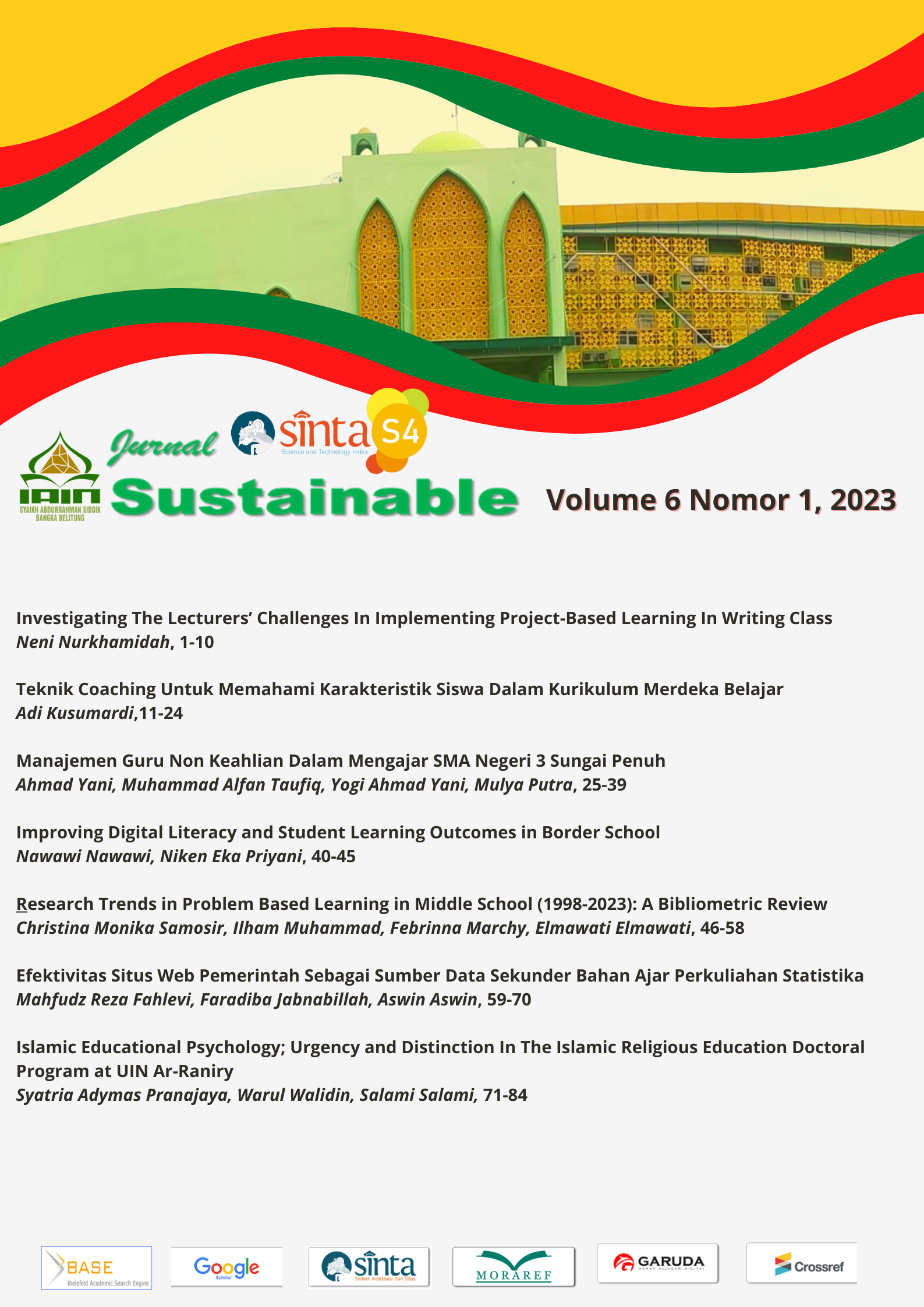Application of Mosaic Technique to Develop Children's Fine Motor Skills in PAUD Nurul Iman
Abstract
From birth to six years of age, children participate in Early Childhood Education (ECE), a pre-basic education program that aims to prepare them for future learning through formal, non-formal, and informal means by providing them with educational stimuli that support their physical and spiritual development. Along with physical growth, children undergo a period of increased self-awareness, social competence, and environmental understanding throughout the early years of life. Researchers at PAUD Nurul Iman Desa Talang Baru want to learn more about the effects of mosaic techniques on the development of fine motor skills in young children so they can plan an appropriate study. The term "Classroom Action Research" comes from the English word "classroom research," meaning "research done in a class to find out the consequences of actions applied to a research subject in the class." This study draws on classroom actions to answer the research question. The study and conversations done led to the conclusion that the mosaic approach may help the group A children of TK ABA Khadijah Bangunjiwo Timur Kasihan Bantul strengthen their fine motor abilities.
Downloads
References
Agustina, E. A., Agatha, S. N. S., & Widiyaningrum, N. (2022). Mengembangkan Motorik Kasar Aud Dengan Bermain Permainan Tradisional. AT-THUFULY : Jurnal Pendidikan Islam Anak Usia Dini, 2(2), 92–97. https://doi.org/10.37812/atthufuly.v2i2.583
Alfiyanto, A. (2020). UPAYA MENINGKATKAN KEMAMPUAN KOGNITIF ANAK MENGENAL ANGKA DI PAUD KASIH IBU. Jurnal Migasian. https://doi.org/10.36601/jurnal-migasian.v4i1.98
Chen, Y. J., Fei, X., Wu, T. C., Li, H. J., Xiong, N. N., Shen, R. Y., Wang, Y., Liang, A. M., & Wang, H. (2022). The relationship between motor development and social adaptability in autism spectrum disorder. Frontiers in Psychiatry, 13. https://doi.org/10.3389/fpsyt.2022.1044848
Juwaeriah, S., Muhyani, M., & Ikhtiono, G. (2017). PENGARUH MODEL PEMBELAJARAN KOOPERATIF TIPE JIGSAW TERHADAP MOTIVASI BELAJAR DAN HASIL BELAJAR SISWA PADA MATA PELAJARAN MATEMATIKA. Attadib: Journal of Elementary Education, 1(2), 78–93. https://doi.org/10.32507/attadib.v1i2.24
Khaerudin, M. J. (2007). Kurikulum Tingkat Satuan Pendidikan, Konsep dan Implementasi di Madrasah. Nusa Aksara.
Kurnia, L., & Rosdianti, I. (2023). UPAYA PENGEMBANGAN MOTORIK HALUS ANAK USIA DINI MELALUI TEKNIK MOZAIK. Jurnal PIAUD La Tansa Mashiro, 4(1). https://doi.org/http://dx.doi.org/10.55171/jaa.v4i1.923
Kurniasih, I., & Sani, B. (2015). agam Pengembangan Model Pembelajaran untuk Peningkatan Profesionalitas Guru. Kata Pena.
Kustandi, C., & Sutjipto., B. (2013). Media Pembelajaran Manual dan Digital. Jurnal Basicedu.
Mardiana, M., Parwoto, & Ilyas, S. N. (2021). Pengaruh Kegiatan Bermain Kreasi Mozaik Dengan Wallpaper Terhadap Kemampuan Motorik Halus Anak Usia 5-6 Tahun. GENERASI EMAS : Jurnal Pendidikan Islam Indonesia, 4(2), 53.
Odera, F. Y. (2011). Motivation : the most Ignored Factor in Classroom Instruction in Kenyan Secondary Schools. International Journal of Science and Technology.
Rusman. (2013). Model-Model Pembelajaran: Mengembangkan profesinalisme Guru. Rajawali Pers.
Safira, N., & Hidayah, A. (2022). Pendidikan Kecakapan Hidup (Life Skill) Untuk Anak Usia Dini. Jurnal Indonesia Sosial Teknologi, 3(9). https://doi.org/10.36418/jist.v3i9.489
Sanjaya, W. (2009). Strategi Pembelajaran Berorientasi Standar Proses Pendidikan. Kencana.
Sugiyono. (2017). Metode Penelitian Kuantitatif dan Kualitatif dan R&D. ALFABETA.
Sulistyorini, S. (2007). Pembelajaran IPA Sekolah Dasar. Tiara Wacana.
Ummah, M. K., & Hamna. (2021). The Effectiveness of Jigsaw Learning Model by Using Numbered Cards: Strategy for Increasing Mathematics Learning Motivation Students in Elementary School. Pedagogik Journal of Islamic Elementary School.
Von Suchodoletz, A., Lee, D. S., Henry, J., Tamang, S., Premachandra, B., & Yoshikawa, H. (2023). Early childhood education and care quality and associations with child outcomes: A metaanalysis. PLoS ONE, 18(5 May). https://doi.org/10.1371/journal.pone.0285985
Wahyudi, I. N., & Nurjaman, I. (2018). Pengaruh Kegiatan Mozaik Terhadap Kemampuan Motorik Halus Anak Usia 4-6 Tahun. Ceria: Jurnal Program Studi Pendidikan Anak Usia Dini, 6(2), 12. https://doi.org/10.31000/ceria.v7i1.560
Yuliani, W. (2019). Pengaruh Metode Kooperatif Learning Tipe Jigsaw Terhadap Kemandirian Belajar Peserta Didik Kelas Vi Sdn Tunas Bakti Subang Tahun Pelajaran 2018 / 2019. Quanta, 4(1), 44–51. http://e-journal.stkipsiliwangi.ac.id/index.php/quanta/article/view/1709
Yulitasari, D. (2018). Pengaruh Pemanfaatan Media Video terhadap Motivasi dan Hasil Belajar IPA Siswa Kelas V Sekolah Dasar. Magister Pendidikan Dasar Universitas Terbuka.
Copyright (c) 2023 Mirian Susanti, Manto Manto

This work is licensed under a Creative Commons Attribution 4.0 International License.






.png)
